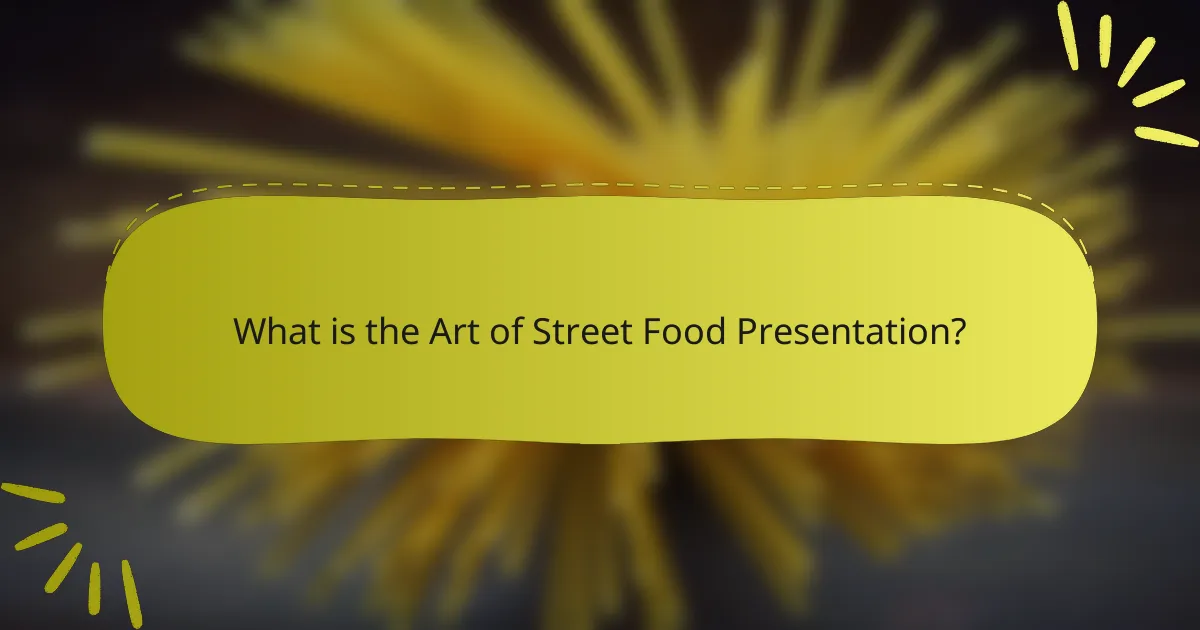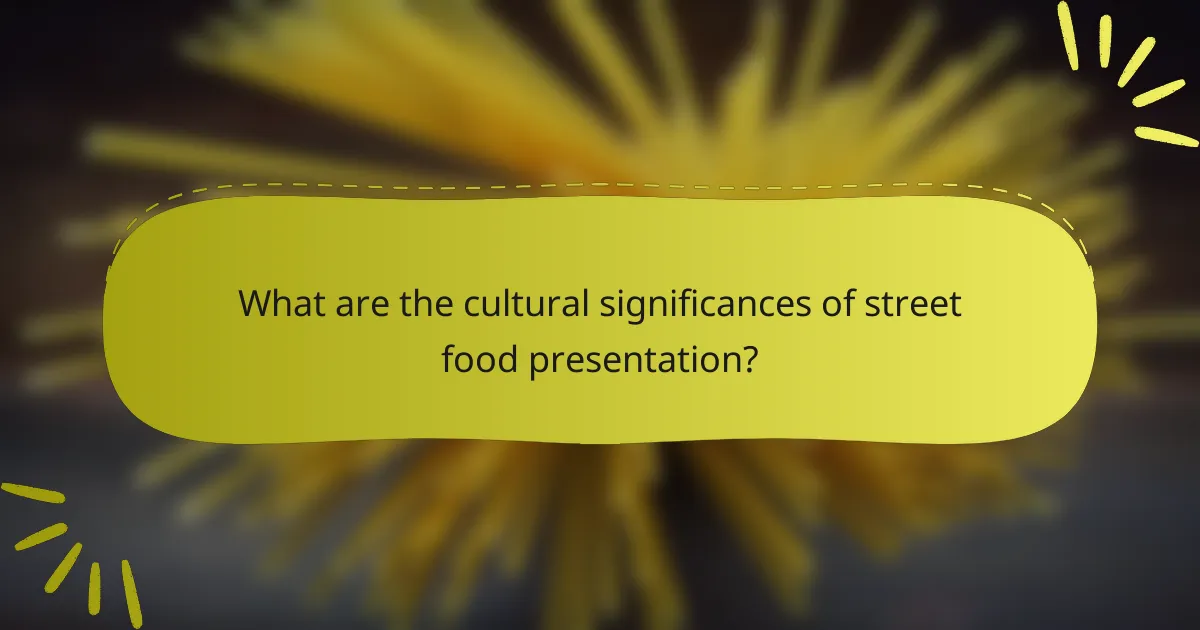The article focuses on the art of street food presentation, emphasizing its role in enhancing visual appeal and attracting customers. Key techniques discussed include the use of vibrant colors, creative plating, and unique serving vessels, all of which contribute to a more enjoyable dining experience. The cultural significance of presentation is highlighted, showcasing how it reflects local traditions and culinary heritage. Additionally, the article explores how effective presentation can influence perceptions of taste and quality, ultimately helping street food vendors differentiate their offerings in a competitive market.

What is the Art of Street Food Presentation?
The art of street food presentation involves the aesthetic arrangement of food to enhance visual appeal. It plays a crucial role in attracting customers and enhancing their dining experience. Effective presentation techniques include colorful ingredients, creative plating, and the use of unique serving vessels. These elements can evoke emotions and stimulate appetite. Cultural significance is also important, as presentation styles often reflect local traditions and culinary heritage. Studies show that visually appealing food can increase perceived taste and enjoyment. Therefore, street food vendors often invest in presentation to differentiate their offerings in a competitive market.
How does visual appeal influence street food culture?
Visual appeal significantly influences street food culture by attracting customers and enhancing their dining experience. Bright colors and artistic presentations often entice passersby, creating an immediate desire to taste the food. Vendors frequently use eye-catching displays to showcase their offerings, making them stand out in crowded markets. Research indicates that visually appealing food can increase perceived taste and quality. A study published in the journal “Appetite” found that attractive food presentation leads to higher satisfaction levels among consumers. This connection between visual aesthetics and consumer behavior is crucial in street food culture, where competition is fierce. Ultimately, the visual appeal of street food not only boosts sales but also fosters a vibrant culinary atmosphere.
What role does color play in street food presentation?
Color significantly enhances street food presentation. It attracts attention and stimulates appetite. Bright colors can evoke feelings of freshness and flavor. For instance, vibrant greens in salads or reds in sauces signal healthiness and taste. Studies show that colorful dishes can increase perceived value and desirability. A visually appealing plate can lead to higher sales. Additionally, cultural significance often ties specific colors to certain foods. In many cultures, red signifies good fortune, while green represents health. Overall, color plays a crucial role in making street food appealing and memorable.
How does texture contribute to the overall appeal of street food?
Texture significantly enhances the overall appeal of street food. It creates a multi-sensory experience that engages diners. The contrast between crispy, chewy, and creamy elements can evoke excitement. For instance, a crunchy topping on a soft filling adds complexity to each bite. This variety in texture can also influence flavor perception. A study by the University of Oxford found that texture affects taste experiences. Additionally, the tactile sensation of food can evoke memories and emotions. Street food often features diverse textures, making it memorable and enjoyable. Overall, texture plays a crucial role in attracting customers and enhancing satisfaction.
Why is plating technique important in street food?
Plating technique is important in street food because it enhances visual appeal and influences consumer perception. A well-presented dish can attract more customers and create a memorable dining experience. Research shows that visually appealing food is often perceived as more delicious. For example, a study published in the journal “Appetite” found that presentation significantly affects taste perception. Additionally, effective plating can showcase cultural significance and traditional elements of the cuisine. This connection fosters appreciation and respect for the food’s origins. Overall, plating is a vital aspect that impacts marketing, customer satisfaction, and cultural representation in street food.
What are the key elements of effective plating techniques?
Effective plating techniques include balance, color, texture, and height. Balance ensures that the plate feels harmonious. Color adds visual interest and stimulates appetite. Texture creates contrast, enhancing the sensory experience. Height adds dimension and draws the eye. Arrangement is crucial; it guides the viewer’s focus. Portion size must be appropriate for the dish. Cleanliness of the plate is essential for a professional look. Each of these elements contributes to an appealing presentation that enhances the dining experience.
How can plating enhance the dining experience of street food?
Plating enhances the dining experience of street food by improving visual appeal and creating an inviting presentation. A well-plated dish stimulates the senses, making the food more enticing. It can highlight the freshness and quality of ingredients used. Plating techniques can also reflect cultural significance, adding context to the meal. For example, using traditional serving methods can evoke a sense of authenticity. Research shows that food presentation influences taste perception and enjoyment. According to a study published in the Journal of Sensory Studies, visually appealing dishes are often rated as more delicious. This suggests that effective plating can elevate the overall experience of street food.

What are the cultural significances of street food presentation?
Street food presentation holds significant cultural value as it reflects local traditions and culinary practices. The visual appeal of street food can enhance the dining experience and attract customers. In many cultures, the way food is presented is tied to social status and regional identity. For example, vibrant colors and intricate designs often signify cultural heritage. Additionally, presentation can influence perceptions of taste and quality. Studies show that attractive food presentation can increase appetite and enjoyment. In some regions, unique serving methods, like using traditional utensils, reinforce cultural identity. Overall, street food presentation serves as a form of expression and connection to cultural roots.
How does street food presentation reflect local traditions?
Street food presentation reflects local traditions through unique serving styles and cultural symbolism. Each region showcases its heritage through specific plating techniques. For example, in Thailand, vibrant colors and fresh herbs are used to emphasize freshness and flavor. In Mexico, food is often served in traditional pottery, highlighting indigenous craftsmanship. The arrangement of ingredients can also signify cultural rituals or celebrations. In India, street food is presented on banana leaves, representing sustainability and local customs. Such practices not only enhance visual appeal but also connect consumers to the cultural narratives of the food. Local traditions are thus preserved and promoted through these distinct presentation methods.
What cultural symbols are often represented in street food presentation?
Cultural symbols in street food presentation often include traditional colors, patterns, and serving styles. For example, vibrant colors can represent cultural festivities. Specific patterns may reflect regional heritage or craftsmanship. Serving styles often utilize traditional utensils or packaging that signify cultural identity. In many cultures, the arrangement of food can symbolize abundance or hospitality. For instance, in some Asian cultures, food is served in a communal style to promote sharing. These visual elements enhance the cultural experience and connect consumers to the tradition behind the food.
How do different cultures approach the art of plating?
Different cultures approach the art of plating with unique techniques and aesthetic values. In Japan, presentation emphasizes minimalism and balance, often using natural elements like leaves or stones. French cuisine focuses on elegance, with intricate arrangements and sauces artfully drizzled. In contrast, Mexican plating celebrates vibrant colors and bold flavors, often showcasing multiple ingredients together. Indian cuisine features elaborate presentations, highlighting spices and textures in a visually rich manner. Each culture’s approach reflects its culinary traditions and values, influencing how food is perceived and enjoyed.
Why is storytelling important in street food presentation?
Storytelling is important in street food presentation because it creates an emotional connection with customers. This connection enhances the overall dining experience. When vendors share the origins of their dishes, it adds depth and context. Customers are more likely to appreciate the flavors and ingredients when they understand their background. Studies show that storytelling can increase customer engagement and satisfaction. For example, a 2019 study published in the Journal of Consumer Research found that narratives can enhance the perceived value of food experiences. Therefore, effective storytelling can differentiate street food vendors in a competitive market.
How can street food tell a story through its presentation?
Street food can tell a story through its presentation by reflecting cultural heritage and culinary traditions. The colors, textures, and arrangement of ingredients often signify the region’s history and local customs. For example, vibrant colors may represent freshness and local produce, while specific plating techniques can indicate traditional cooking methods. Additionally, the use of local utensils or serving styles can enhance the narrative of the dish. This visual appeal engages customers and evokes memories or emotions related to the culture. Studies show that food presentation influences perception and enjoyment, reinforcing the connection between visual elements and storytelling in cuisine.
What elements contribute to the narrative aspect of street food plating?
The narrative aspect of street food plating is shaped by cultural context, visual aesthetics, ingredient choice, and presentation style. Cultural context informs the story behind the dish, reflecting traditions and regional flavors. Visual aesthetics play a crucial role in attracting attention and evoking emotions. Ingredient choice contributes to the narrative by highlighting local produce and flavors. Presentation style, including the arrangement and use of colors, enhances the overall storytelling experience. These elements work together to create a compelling narrative that engages the consumer.

What are some effective techniques for enhancing street food presentation?
Effective techniques for enhancing street food presentation include using vibrant colors, creative plating, and thematic garnishes. Vibrant colors attract attention and stimulate appetite. Creative plating involves arranging food in an aesthetically pleasing manner. Thematic garnishes can emphasize cultural elements and enhance visual storytelling. Using unique serving vessels can also elevate the overall experience. Additionally, incorporating fresh herbs or edible flowers adds a touch of elegance. Consistency in presentation across dishes reinforces brand identity. Finally, engaging lighting can enhance the visual appeal, making the food more enticing.
What are the best practices for plating street food?
Use clean, appropriate containers for street food plating. Containers should be sturdy and visually appealing. Ensure that the food is arranged attractively within the container. Use vibrant colors to enhance visual appeal. Incorporate garnishes that complement the dish. Maintain balance in portion sizes for aesthetic symmetry. Consider the cultural significance of the dish in its presentation. Use minimalistic design to highlight the food itself.
How can garnishing improve the aesthetic of street food?
Garnishing enhances the aesthetic of street food by adding color, texture, and visual interest. Brightly colored garnishes attract attention and stimulate appetite. They can also provide contrast to the main dish, making it more visually appealing. Textural elements, such as crispy herbs or crunchy seeds, enhance the overall experience. Additionally, garnishing can reflect cultural significance, showcasing local ingredients and traditions. Studies indicate that visually appealing food can increase perceived taste and enjoyment. Thus, effective garnishing is crucial in street food presentation.
What tools can be used to achieve professional-looking street food presentation?
Plating tools can be used to achieve professional-looking street food presentation. Essential tools include plating rings, squeeze bottles, and tweezers. Plating rings help create structured layers and shapes. Squeeze bottles allow for precise sauce application and decorative designs. Tweezers enable careful placement of garnishes and delicate ingredients. Additionally, using high-quality plates enhances the overall presentation. Colorful napkins and unique serving containers can also elevate visual appeal. These tools support creativity and professionalism in street food presentation.
How can vendors create a memorable visual experience for customers?
Vendors can create a memorable visual experience for customers by focusing on aesthetic presentation and vibrant colors. Engaging plating techniques enhance the visual appeal of street food. Using fresh ingredients adds to the overall attractiveness. Unique serving styles, such as creative containers, can captivate attention. Incorporating cultural elements in presentation connects with customers emotionally. Research shows that visually appealing food can increase appetite and enjoyment. A study published in the Journal of Sensory Studies found that presentation significantly impacts perceived taste. Therefore, vendors should prioritize visual elements to enhance customer experience.
What strategies can be employed to attract customers through presentation?
Employing visually appealing presentation strategies attracts customers effectively. Utilizing vibrant colors in food enhances visual appeal. Arranging food artfully on plates creates an inviting look. Incorporating cultural elements in presentation resonates with target audiences. Using unique serving vessels adds a distinctive touch. Highlighting freshness through garnishes signifies quality and taste. Engaging storytelling through presentation can captivate customers. Research indicates that attractive food presentation increases perceived value and purchase intent.
How does presentation impact customer perception of quality in street food?
Presentation significantly impacts customer perception of quality in street food. Visually appealing food attracts customers and creates a favorable first impression. Studies show that consumers often associate well-presented dishes with higher quality. For example, a 2018 study published in the Journal of Sensory Studies found that food presentation influenced taste perception. The research indicated that attractive plating can enhance the perceived flavor and overall experience. Additionally, cultural significance plays a role in presentation, as traditional plating techniques can evoke nostalgia and authenticity. Thus, effective presentation not only draws attention but also enhances perceived quality and enjoyment.
What practical tips can vendors use to enhance their street food presentation?
Vendors can enhance their street food presentation by focusing on vibrant colors and appealing arrangements. Brightly colored ingredients attract customers and create visual interest. Using attractive serving dishes or containers can elevate the perceived value of the food. Cleanliness and organization of the food stall contribute to a professional appearance. Incorporating garnishes adds a finishing touch that enhances the overall look. Utilizing signage with clear, appealing fonts can inform customers while maintaining aesthetic appeal. Consistent branding through colors and logos can create recognition and loyalty. Engaging with customers through presentation and interaction can further enhance the experience.
The main entity of this article is street food presentation, which emphasizes the aesthetic arrangement of food to enhance visual appeal and attract customers. The article covers key aspects such as the influence of visual appeal on street food culture, the role of color and texture in enhancing presentation, and the importance of plating techniques. Additionally, it explores the cultural significance of presentation, how storytelling can enrich the dining experience, and effective strategies for vendors to improve visual appeal and customer perception of quality. Overall, the content highlights the intersection of aesthetics, cultural heritage, and marketing within street food presentation.